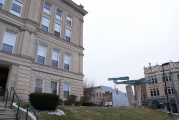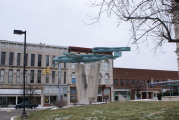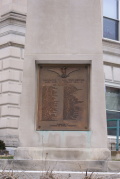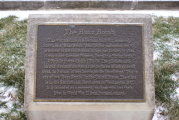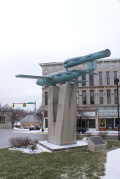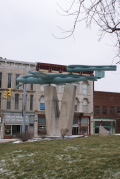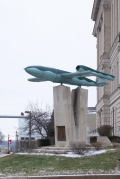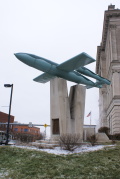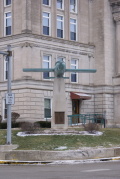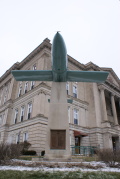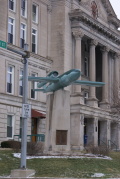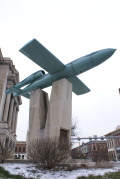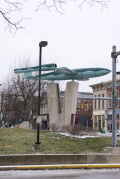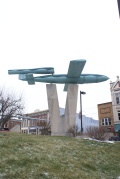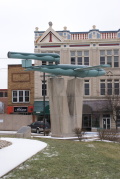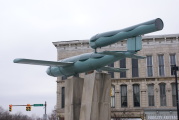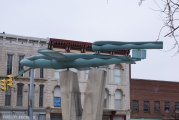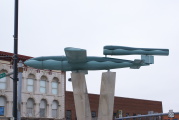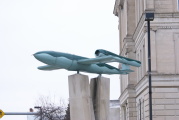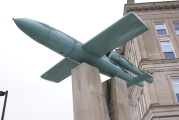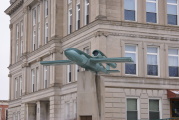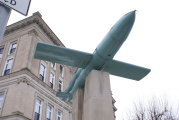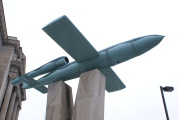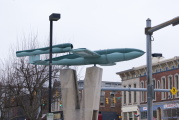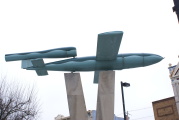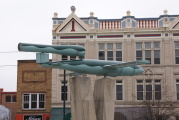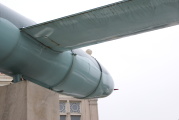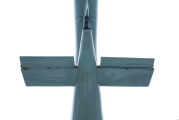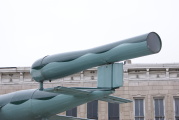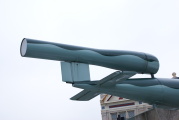Return to Greencastle Indiana
V-1
The city of Greencastle, Indiana displays a captured German V-1 on a V-shaped pedestal in front of the Putnam County court house as a memorial to those from Putnam County who lost their lives in World War II.
The V-1 made its way to Greencastle through the efforts of J. Frank Durham, a Greencastle resident. During the spring of 1947 source), Durham, a naval reservist was undergoing explosive ordnance demolition at Fort Stumpneck, Maryland. One of his tasks was to help dispose of obsolete captured enemy ordnance taking up unnecessary room.
Durham thought it was a shame to dispose of the items and wanted to donate some of the gear to the Greencastle VFW post. His officer-in-charge remarked that it would take an "act of Congress" to make such a procurement, so Durham contacted his representatives, who eventually arranged for the V-1 and other equipment to be transferred. ("Act of Congress" may be something of an overstatement, as the only such reference I could find was a passing mention of "Public Law 649", which appears to have been the Military Appropriation Act of 1943. After the war, it seems that the act was used to transfer excess military hardware to various museums and organizations; for example, the battleship U.S.S. Texas was transferred to the state of Texas by the Secretary of the Navy and the German U-Boat U-505 was transferred to Chicago's Museum of Science & Industry through Public Law 649.)
However the Indiana Congresscritters managed it, local businesses donated money and services to prepare the V-1 as a monument. State Senator William B. Hoadley, who lost his only son in the war, owned a limestone quarry and donated the limestone for the "V" pedestal (this was apparently the largest single piece of limestone ever quarried from Hoadley Limestone Quarries). The monument committee took pains to ensure that the list on the monument would include every local veteran killed in the war.
The monument was unveiled on Armistice Day, 1948, with Rear Admiral A.G. Noble, Chief of the Bureau of Ordnance, speaking at the dedication. A crowd of 5,000 people were on hand for the occasion.
A number of sources put the timeline of the Greencastle buzz bomb one year earlier, with Durham at Stumpneck in spring of 1946 and the dedication in 1947. However, an Internet search of period newspapers shows that the 1947/48 timeline is most likely correct.
After the war, Durham practiced probate law in Greencastle through the end of 2010. A local shopkeeper told me that he used to see Durham walking to his office near the court house every day. Durham passed away on May 20, 2011 at the age of 95, after practicing law for nearly 70 years. Before his passing, he endowed a fund to "support the care and maintenance" of the memorial.
At the time the memorial was emplaced, Greencastle believed that its V-1 was one of only two in America (the other one being the one in the collection of the Smithsonian Institute). This seemed like a reasonable assumption at the time, but several other American museums do display V-1s which survived Ft. Stumpneck's purge—or were sourced elsewhere (although several so-called of these V-1s are actually JB-2 Loons, the American version of the V-1).
The V-1, whose skin was made of mild steel, was really not meant for long-term, outdoor display. It was repainted in April of 1963 as part of a Phi Delta Theta project of cleaning up and renovating the Putnam County court house and was refurbished in 1981, but eventually the V-1 began to rust, staining the "V" pedestal. VFW Post 1550 removed the buzz bomb for restoration in 2004. During the nearly two-year project, volunteers rebuilt the wings and rear tail section, removed all rust and corrosion, and reskinned the V-1, replacing much of the original material with stainless steel (making it, like so many restored aircraft, something of a ship of Theseus). The V-1 was returned to its pedestal on August 13, 2006.
The Air Force Museum's web site has a number of V-1-related images, including a photo of a V-1 launch emplacement and a picture capturing a V-1 moments before impact. The Smithsonian has a detailed V-1 page (be sure to click the "Long Description" button). I also have a page of V-1 cut-away drawings. Finally, the Putnam County Convention and Visitors Bureau previously had a page with information about the V-1, which is now provided by archive.org's Wayback Machine.
The Wayback Machine also saved a photo of the V-1 prior to its 2006 refurbishment. The V-1 has a Facebook page which includes an undated, vintage photo of the V-1, apparently before a proper nosecone had been fabricated for it.

